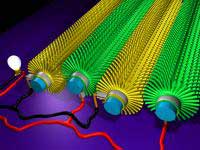Feb 14 2008
Nanotechnology researchers at the Georgia Institute of Technology are developing a shirt that harvests energy from the wearer's physical motion and converts it into electricity for powering small electronic devices worn by soldiers in the field, hikers and other users.
 A schematic illustration of a "bottle-brush " structure shows nanowires arranged around a fiber. The relative "scrubbing " of the two brushes generates electricity.
A schematic illustration of a "bottle-brush " structure shows nanowires arranged around a fiber. The relative "scrubbing " of the two brushes generates electricity.
The research, funded by the National Science Foundation (NSF) and described in the Feb. 14 issue of Nature, details how pairs of textile fibers covered with zinc oxide nanowires generate electricity in response to applied mechanical stress. Known as "the piezoelectric effect," the resulting current flow from many fiber pairs woven into a shirt or jacket could allow the wearer's body movement to power a range of portable electronic devices. The fibers could also be woven into curtains, tents or other structures to capture energy from wind motion, sound vibration or other mechanical energy.
"The two fibers scrub together just like two bottle brushes with their bristles touching, and the piezoelectric-semiconductor process converts the mechanical motion into electrical energy," Zhong Lin Wang, a Regents professor in the School of Materials Science and Engineering at the Georgia Institute of Technology. "Many of these devices could be put together to produce higher power output."
Wang and collaborators Xudong Wang and Yong Qin have made more than 200 of the fiber nanogenerators. Each is tested on an apparatus that uses a spring and wheel to move one fiber against the other. The fibers are rubbed together for up to 30 minutes to test their durability and power production.
The researchers have measured current of about four nanoamperes and output voltage of about four millivolts from a nanogenerator that included two fibers that were each one centimeter long. With a much improved design, Wang estimates that a square meter of fabric made from the special fibers could theoretically generate as much as 80 milliwatts of power.
So far, there is only one wrinkle in the fabric, so to speak - washing it. Zinc oxide is sensitive to moisture, so in real shirts or jackets, the nanowires would have to be protected from the effects of the washing machine.